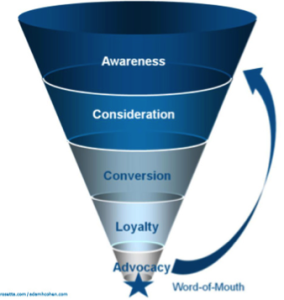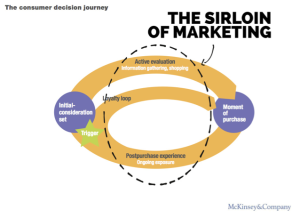Traditional marketing was known for its inside out approach. The idea was to create a cumulative series of messages known as brand impressions. Marketers bought media and launched campaign after campaign designed to generate sufficient awareness so the consumer would respond to these messages at the point of purchase and buy the product.
Hannah Grove, executive vice president and chief marketing officer at State Street Corporation calls this a cathedral model; it’s where all you do is push top-down messages. In this world, a brand largely talks about themselves, their products and services and how they are better than the competition.
In an interview with MIT Sloan Management Hannah describes a paradigm shift to a social business model, She calls it a marketplace model where the client is the center of the universe. In this world the focus is creating value for the clients, allowing them to gather more insights, more information, and to help them overcome the challenges they are facing.
Hannah is describing the essence of Customer Experience Marketing, it is a paradigm shift and changing paradigms isn’t easy. In the interview she talks about the value and necessity of a social business approach in achieving a customer-centric focus.
I believe there are five design principles that drive social Customer Experience Marketing.
Building the Right Culture
There is a growing body of evidence that suggests engaged employees help businesses in several important ways. Gallup researchers studied performance differences between engaged and actively disengaged work units and found the top quartile outperformed the bottom quartile units by:
- 10% on Customer Ratings
- 22% in profitability
- 21% in productivity
There were substantial differences in other factors such as turnover, absenteeism, shrinkage, and safety incidents to name just a few.
Building a culture that allows engaged employees to thrive requires leadership and a strategy. In her interview, Hannah Grove talks about Collaborate, which is their strategy to engage their employees on social tools.
She describes a cautious, deliberate effort to educate, then gradually rollout the effort. What’s key to this strategy is the recognition that a different mindset is required. If you are going to embrace client-centric marketing you have to become a client-centric organization.
Each organization has to discover the approach that best fits their business model; there is no one size fits all. A culture that embraces learning and collaboration will certainly have an advantage. Delivering a client-focused experience requires cross-functional collaboration, so make sure all functions within the company are appropriately represented in this effort.
Creating, Curating and Repurposing Content
Relevant content is key to helping customers gather the insights and information to overcome their challenges. This is the ultimate objective of the client-centric approach Hannah was talking about earlier.
Content is the new currency of marketing. Consumer behavior and expectations are rapidly evolving; driven by technology and social platforms. Consumers are empowered and connected in ways that have left many brands lagging far behind their expectations.
Creating content is just that – original material authored by your organization. This content can be generated by volunteers or contracted external writers. There are many strategies to source this kind of material.
Curating content is sharing the work of others to benefit your audience. This strategy helps you engage with those in the broader marketing ecosystem and often elevates your role as a thought leader in your niche.
I first heard about repurposing content when I read Content Rules by Ann Handley and C.C. Chapman. In this terrific work they offer a number of suggestions and strategies for creating and curating content. They talk about repurposing content. This speaks to the essence of providing useful content; it’s content tailored for the specific platform and the appropriate stage in the buying journey. The book is an excellent resource.
I recommend starting with a Content Strategy. This approach will help you outline the types of content that will help your customers at each point in the buying journey. Keep in mind post purchase content is often most helpful and useful to customers.
Next I suggest an editorial calendar. Creating and curating content requires discipline and coordination. I find this tool is helpful in organizing and coordinating this effort; this is particularly important when collecting content from volunteer authors within the organization.
Know Your Customer’s Buying Journey
Most of us are familiar with the iconic buying or purchasing funnel. The basic idea is one starts with a large number of suspects and prospects at the top of the funnel and as one progresses through the funnel the role of marketing is to qualify, nurture and convert suspects to prospects, then prospects to qualified leads, qualified leads to closed sales, and finally repurchases as appropriate.
The very nature of the model assumes a somewhat linear process. Basically you start at the top and move through the funnel, assuming of course, that you aren’t filtered out.

image credit http://adamhcohen.com/the-new-marketing-funnel/
Recent research by McKinsey & Company suggests the buying process is very different. Far from linear, it’s circular and complex. More importantly it recognizes the importance of the post purchase experience and the role this plays in future purchase decisions.

I recommend mapping the buying journey for several reasons. It’s an excellent way to initiate cross-functional collaboration. The process typically identifies gaps in the customer experience that can and should be addressed.
This exercise usually helps to promote engagement on the part of the participants and it models the type of alignment that can result from client-focused collaboration and insight.
Designing a Seamless Experience
A GfK study indicated that 6 in 10 online adults in the US and UK use at least 2 devices every day, with 25% in the UK and 20% in the US using at least 3 devices.
A large portion of the multi device users, 53% of online American adults, start one activity on one device then switch to another to complete the activity. This number jumps to 77% of those who own 3 devices.
I have seen other studies reflecting similar results.
Consumers increasingly want to engage with brands that allow them to connect when, where, and how they choose. Offering this kind of utility requires collaboration and coordination.
At a minimum you need to ensure that consumers are able to interact with your brand on mobile devices. I strongly suggest that you experience this for yourself. If you haven’t already, try the searching and buying experience from your smartphone or tablet. What’s the experience?
Can you find what you are looking for?
Is it convenient? What Happens when you switch devices during the process? You will quickly discover there is more involved that just adaptive design.
You may want to survey your customers to find out what they think.
Building a Community
Social tools play an important role in building internal and external communities and both are vital to Customer Experience Marketing.
Externally facing platforms like Facebook, Linkedin, Twitter, You Tube and Pinterest are available to marketers. These are just a few of the many options available. The key is discovering the platforms your customers use.
Facebook is by far the largest social platform accounting for approximately 71% of Internet users.
While LinkedIn represents a mere 22% a closer look reveals that the numbers rise to 38% when targeting audience with higher education, defined as college or post graduate education.
Pinterest, Twitter and Instagram all have similar popularity ranging from 17%-21% of Internet users.
Don’t overlook role of email 71% to 85% open emails on their smartphone. The percentage varies by age demographic with the highest percentage among those (30 to 39) and the lower (50 to 59) based on a survey by Constant Contact.
There are also internal tools like Yammer. In many instances organizations have Intranets that provide many options for sharing and collaborating.
Building a community requires patience, skill and focus. Social media guidelines and policies are important foundational building blocks. There are a number of free templates available. If your organization is in a regulated industry, you’ll also need to deal with governance issues.
Education and support from senior leaders is extremely important in developing thriving internal communities and thriving internal communities are necessary to engage external client-focused communities. You’ll regularly find a wealth of useful information about specific social media platforms on the Maximize Social Business Blog.
Getting Started
If you are interested in learning more about the social business approach I highly recommend Neal Shaffer’s book Maximize Your Social. In his book he provides more detail on these and other important principles.
People still want to do business with people. Those brands that embrace the Social Customer Experience are better equipped to provide that kind of experience, and when they don’t, they usually have feedback to raise their awareness, allowing them to address these gaps.
If your organization hasn’t embraced this strategy perhaps you can begin by implementing some of these principles in your area.
Can you think of any brands doing this well?



